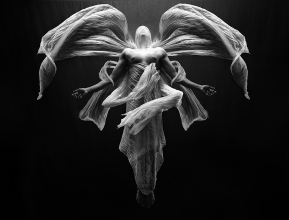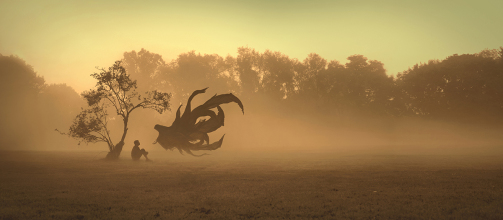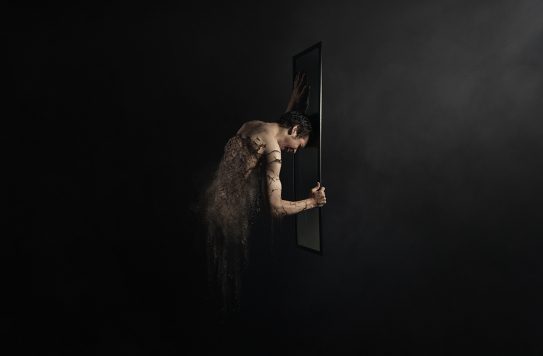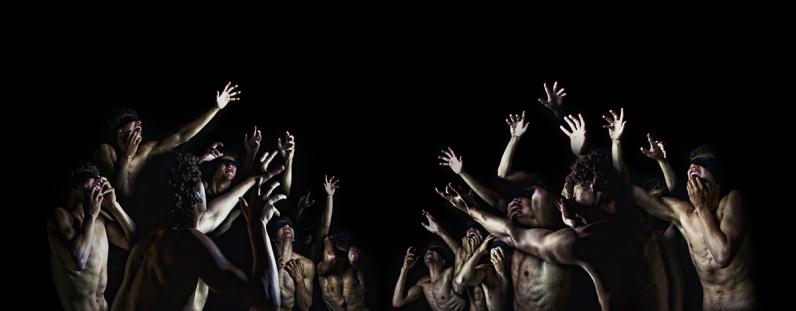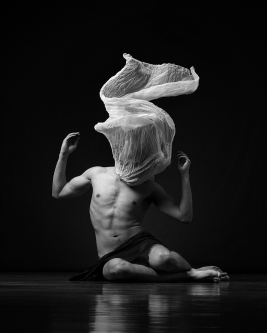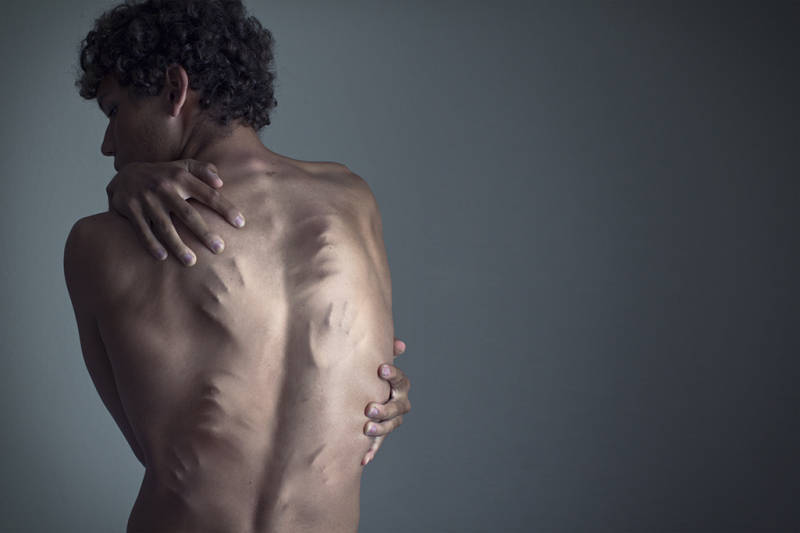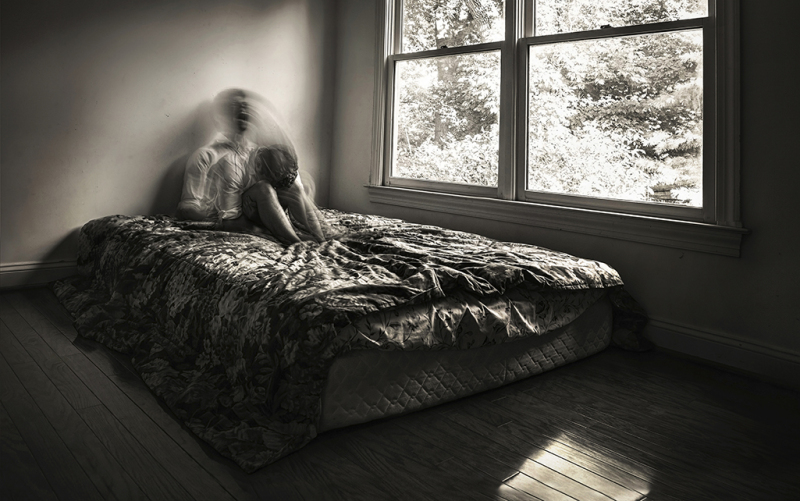We at platform PHOTO recently had the pleasure of interviewing young photographer Christian Hopkins, whose images experiment with combining self-portraiture and conceptual techniques, achieving dramatic and emotive results. Christian’s path into the photographic world was instigated when he received a camera as a gift and despite his reservations, forced himself to start photographing. Photography made him see the world in a more beautiful light and soon became a tool for Christian in battling his demons, providing a form of therapy in coping with his depression and allowing him a channel to communicate his emotions. Here, Christian opens up to us, offering an insight into his often arduous and meticulously thought out photographic process.
platformPHOTO: Hi Christian, please tell us about yourself, your life and how you discovered photography.
Christian Hopkins: It’s difficult to talk about myself with any sort of brevity, not quite because I have so much to say about myself, rather, talking about myself and my life in such a small space means I need to identify the most defining aspects of myself and how I’ve spent the last 20 years on this earth. I can say with confidence that I cannot confidently say I know what those are. I had always been a wallflower. My opinions were simply a reflection of whoever was speaking to me, and to describe my true self was akin to describing the color of a mirror. Ironically, I had simultaneously held a feverish desire to break away from the mundane and seek undiscovered beauty. I was often called the “creative” one whenever I was in a situation that involved art or expression because I was never satisfied with taking the obvious path and becoming forgettable. I wanted to take that path and mold it, twist it into something that was beautiful, yet made you question the reality of the path itself. Indirectly, it was that desire that got me into photography. I was going on a trip to China and my mom bought me a high-end point-and-shoot that I wanted nothing to do with. Since I was stuck with the thing, I forced myself to take a lot of pictures out of guilt for this “gift.” Of course, I didn’t want to just take pictures, I wanted to take GOOD pictures, or at least try to. Some might say being glued to your viewfinder while on vacation makes you “miss the moment,” but for me it magnified it. I started noticing things like complimentary colors, interesting perspectives, the behavior of light, and everything before me became richer. Since then, that lens became my third eye with which the world become so much more beautiful.
platformPHOTO: Your photographs come across as beautiful and somewhat haunting. To you, what makes a good photograph?
Christian Hopkins: I actually have a mini checklist that I go through when both creating and viewing photographs. It’s all still a bit amorphous, but I’ll assign a handful of attributes to a photograph, and I’ll like a photograph if each of those attributes are unique or engaging in some way. I usually start with subject matter (that’s pretty self explanatory), color, composition, perspective (that might not be the right word, but examples would be like a wide panorama or a tight crop of someones face or an aerial view of the ground), and a some others. Most importantly though are depth and purpose. Depth is the ability for you to get lost in a photo. Where all the prior attributes swirl together and draw you inside the image. These are the images that you just stare at, and you keep seeing something new the longer you look. I also feel a photograph can have a lot more power when it has a meaningful purpose behind it, but keep in mind that none of these are required. They’re just things that I try to change up with each photograph. Never have the same attribute twice in a row (of course not even I can follow these “rules” most of the time).
platformPHOTO: How do you articulate your ideas, from conception to creation and post-production? Tell us about your creative process.
Christian Hopkins: Most of my concepts start with an emotion, particularly one that I cannot explain or identify. I get extremely uncomfortable whenever I’m not in control, and it’s particularly unbearable when that loss of control is coming from something as personal as my own mind. When this happens, I usually sit down and try my best to put that emotion into words. For example, with my picture “Defense Mechanisms,”, my general words were: “I love photography, but I’ve reached a point where my personal expectations of my own work have exceeded my skill level. Now every time I try to take a photo, I get frustrated because I’m never satisfied with the result, but I can’t stop taking pictures because so many people are waiting to see what I’ll make next. It’s all so unbearable that I’d forever cut photography out of my life, remove something that is so close to my heart, just to stop feeling this.” And once the words are there the picture just kind of…appears.
platformPHOTO: How challenging is it to be working alone when creating often complex self-portraits?
Christian Hopkins: Yes…..very, very, yes. I use a remote shutter release, and up until recently, I had this dinky little infrared remote that had an effective range of 10 feet and you had to hit this sweet spot on the camera, so I would spend so much time staring numb at the camera while I futilely press this button and then suddenly the red light will go on and I have two seconds (and no this couldn’t be extended, I tried) to frantically pose, then wait, then *click.* I would have to run and check how the picture turned out after every shot because if I took a whole bunch of poses at once and I didn’t realize I was out of the frame, then all those pictures would be unusable. With some shoots taking hundreds of attempts because I’m a bit of a perfectionist, let’s just say I get a lot of exercise. Also, clamps are a solo self-portraitist’s best friend.
platformPHOTO: Can you give some information about the post-production process to create your images. Do you usually have a clear vision of what you wish to achieve during editing or is it something that happens while you are editing your images? Are there any particular techniques that you use?
Christian Hopkins: Most of the time the photograph is already finished in my before I even pick up the camera. I don’t usually even sketch anything out. I already know what it looks like. I’ve seen it. Taking the picture is just a formality. With my composites, I don’t really have a consistent technique because each one is so very different. What you might call a “technique” I would just call common sense. Start building the background, then cut out and add all the subjects, then match their hues and tones to the background, then overall touch ups, and finally start working with all the adjustment sliders to solidify the tone of the image.
platformPHOTO: Are there any photographers or artists working with other mediums that have been inspiration to you? Perhaps because of their style or the subject matter that they tackle within their work.
Christian Hopkins: Nope.
platformPHOTO: You started photography as a form of therapy in coping with depression, but now it seems as though this medium of expression has become a challenge in itself for you. Have you found that channelling your feelings through conceptual photographs has helped you in dealing with or understanding your depression?
Christian Hopkins: It’s the only tool I have in this fight. How do you fight an enemy you cannot touch, cannot see, and, most distressingly, is yourself? When I create a photograph, it is more than just an image. It’s the manifestation of some demon that has been haunting me to the point where I can no longer function. It’s then that I need to create this picture to take that demon out of my head and onto the screen in front of me. It’s strange, some weeks I’ll refuse to leave my bed because the smallest inclines become mountains, but suddenly it’s 4 in the morning and I’m running around a fog filled field camera in hand for hours trying to find the perfect place to compose this image that I already finished the moment I got out of bed. It’s the sense of control that leads me to create. It’s knowing that now I am the one now who is creating the image, I am the one who chooses what goes where, who does what, and why they do it. Being able to convey an emotion through something I create proves to me that I now understand this emotion enough to accurately communicate it to others.
platformPHOTO: Last week, you posted a blank image on your flickr account saying goodbye to your followers and that you have decided to give up photography, stating: “I can’t do this anymore….I’m at the point where my expectations have exceeded my capabilities…” Do you still feel this way and would you be able to elaborate on what brought you to this conclusion? Is there any chance that you may return to your personal photography in the future?
Christian Hopkins: Imagine a crowd of over 4 million people, and the spotlight’s on you. There they stand, far beyond the limits of your vision in an infinite black void, all waiting for you to say something, but of course you have nothing to say. Yet they do not budge, and the stillness starts to crush you. Every new moment in the growing silence pushes every word down your throat, and that silence grows stronger because of it, creating an eternal loop of suffocation. And you cannot run, you cannot escape into your mind, because this is your mind. The crowd is there when you sleep, when you eat. It’s under your skin and in your blood, and it drives you mad. That’s what it felt like, no matter how untrue or irrational it seems, that’s what it felt like. Sometimes it would get to the point where I would just hold onto my camera and rock back and forth for hours. That is why I had to stop, but I’m still here, and I’m not done. I’ve found new ways to communicate these emotions through images, and they’re silently screaming to get out.
platformPHOTO: Thank you so much for your time today Christian, we have one last question for you. If we sent you to a desert island and allowed you to take only one picture with you by another photographer, what would this image be?
Christian Hopkins: “The Five Stages of Grief” by Stephen Criscolo (http://www.flickr.com/photos/stevosshots/7462823802/). In my world, it is the most magnificent work of artistic expression that I have ever seen. It is the only thing in my life so far that I’ve chosen to designate as perfect.
To view more of Christian Hopkins’ work visit his flickr account: http://www.flickr.com/photos/chopkins011/

